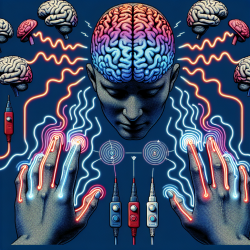The field of noninvasive brain stimulation has been revolutionized by techniques like transcranial direct current stimulation (TDCS). A recent study titled "Contrasting MEG effects of anodal and cathodal high-definition TDCS on sensorimotor activity during voluntary finger movements" sheds light on how different TDCS protocols can impact sensorimotor functions. This blog will explore the study's findings and discuss how practitioners can leverage these insights to improve therapeutic outcomes.
The Study: A Deep Dive into TDCS Effects
The research conducted by Meltzer et al. (2024) focused on understanding the effects of anodal (excitatory) and cathodal (inhibitory) high-definition TDCS on sensorimotor activity. Using magnetoencephalography (MEG), the study measured neural activity before and after TDCS application to the left motor cortex while participants performed simple finger movements.
Key Findings
- Anodal HD-TDCS: Decreased movement-related cortical fields (MRCF) during contralateral right finger movements.
- Cathodal HD-TDCS: Increased MRCF during the same task.
- No significant differences were observed in oscillatory signatures of voluntary motor output or spontaneous resting state oscillations.
Implications for Practitioners
The study's findings suggest that TDCS can modulate sensory processing in a polarity-dependent manner, which is opposite to its effects on motor-evoked potentials (MEPs). This insight is crucial for practitioners aiming to optimize therapeutic interventions using TDCS. Here are some ways to implement these findings:
- Personalized Treatment Protocols: Tailor TDCS protocols based on individual sensory processing needs. For instance, use anodal stimulation to decrease sensory input responses when necessary.
- Sensory Processing Disorders: Consider using cathodal TDCS to enhance sensory input processing in patients with sensory processing disorders.
- Further Research: Encourage ongoing research into the broader applications of TDCS across different cortical regions and conditions.
The Path Forward: Encouraging Further Research
This study opens new avenues for exploring how noninvasive brain stimulation can be fine-tuned for therapeutic purposes. Practitioners are encouraged to stay informed about ongoing research and consider participating in studies that explore the diverse applications of TDCS.
If you're interested in delving deeper into this research, Contrasting MEG effects of anodal and cathodal high-definition TDCS on sensorimotor activity during voluntary finger movements.










